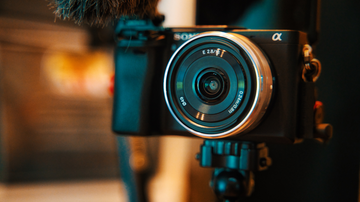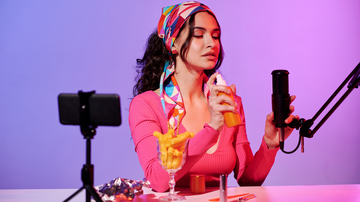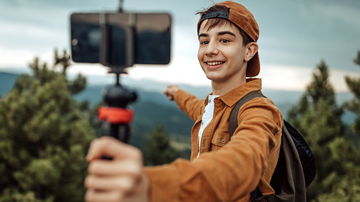The camera in your pocket holds a surprising amount of filmmaking potential. With the right techniques and a bit of creativity, you can transform your smartphone into a powerful tool for capturing cinematic-quality videos. Let's dive into the tips and tricks that will elevate your mobile filmmaking game!
The Building Blocks of Cinematic Visuals
Before we grab our phones and start shooting, it's important to grasp a few fundamental concepts that give films their distinctive look. Framing and composition are critical. Think about how you arrange elements within your shot – the placement of your subject, the use of negative space, and how lines within the frame guide the viewer's eye. A simple technique like the rule of thirds (mentally dividing your image into a 3x3 grid) can instantly improve your compositions.
Lighting plays a pivotal role in setting the mood and atmosphere of your footage. Natural sunlight offers beautiful possibilities, but don't be afraid to experiment with artificial lights as well. Pay attention to the interplay of light and shadow, where highlights fall, and how the direction of light shapes your scene.
Camera movement, when used purposefully, can infuse your videos with a sense of dynamism and professionalism. Smooth pans, tilts, and deliberate handheld work can elevate your shots. However, remember that sometimes the most powerful shot is a static one – overuse of movement can feel distracting.
Finally, color grading is the process of meticulously adjusting the color palette of your footage in post-production. Color choice heavily influences the mood of your video. Warmer tones can evoke feelings of nostalgia or comfort, while a cooler palette might create a sense of tension or drama.
Mastering Your Smartphone's Camera
Most modern smartphones offer a surprising level of manual control over your camera settings. Delve into 'pro' or 'manual' mode within your camera app to unlock adjustments for ISO, shutter speed, white balance, and focus. Experiment with these settings to understand how they affect the look of your footage.
Shooting in 24 frames per second (fps) is a classic filmmaking standard that gives your videos that unmistakable 'cinematic' feel. If your phone supports it, check if you can utilize a 'log' color profile. While footage shot in log format might look flat or washed-out initially, it retains a massive amount of color information, granting you significant flexibility in the color grading process later.
Don't neglect the different lenses your smartphone might offer! Wide-angle lenses are perfect for capturing sweeping landscapes or establishing shots, while telephoto lenses allow you to get closer to your subject without physically moving. Experiment to discover the unique perspectives each lens offers.
Gear to Enhance Your Mobile Filmmaking
While a smartphone alone is remarkably capable, a few key pieces of equipment can take your productions to the next level. A stabilizer or gimbal is a near-essential tool if you want to capture silky smooth footage, especially when incorporating camera movement. Handheld shots have their place, but a stabilizer provides a level of polish that is difficult to achieve otherwise.

An external microphone drastically improves your audio quality. The built-in microphone on your phone is passable for casual use, but if you're recording interviews, dialogue, or sound from a distance, a dedicated microphone will make a world of difference.
ND filters act like sunglasses for your camera's lens, allowing you to shoot with wider apertures (for a shallower depth of field) and slower shutter speeds (for natural-looking motion blur) even in bright conditions.
Specialty lenses like those Wide-Angle Micro Camera Lens can attach directly to your phone, providing options like true optical zoom or even cinematic anamorphic lenses that produce a wider, more film-like aspect ratio.

Cinematic Techniques to Master
Shooting compelling main footage is important, but don't forget about B-roll! These are supplementary shots – close-ups of details, establishing shots of your environment, interesting textures – that provide valuable flexibility in the editing process. If your phone supports it, shooting at a higher frame rate (like 60 or 120 fps) unlocks the potential for beautiful slow-motion sequences.
For more complex shoots, learn about the 180-degree rule. This filmmaking guideline helps maintain consistent screen direction and prevent disorienting cuts between shots. Always consider the intention behind your camera movements – are you panning to follow a moving subject or tilting to create a sense of drama? Motivated camera work serves your story.
Match cuts are a powerful editing technique. Look for opportunities to seamlessly transition between shots that share a similar visual element, composition, or movement – this creates a smooth and visually pleasing flow.
The Magic of Editing
The final stage of filmmaking is where your vision truly comes together. Mobile editing apps like LumaFusion (iOS) and Kinemaster (Android/iOS) offer a remarkable range of tools to refine your footage. Start with basic adjustments like exposure, contrast, and white balance. Experiment with color wheels and saturation to tweak the vibrancy of your colors. LUTs (Look Up Tables) are essentially color grading presets that can instantly give your footage a specific film-inspired aesthetic.

The Power of Story
Remember, all the technical tricks and fancy gear in the world won't compensate for a lack of a strong story. Focus on the narrative you're trying to tell or the emotion you want to evoke. A compelling story, even with some technical imperfections, will always resonate more deeply with viewers than a technically flawless yet empty video.
So, get out there, start experimenting, and embrace the creative possibilities within your smartphone. You might be surprised at the cinematic stories you're capable of telling!




